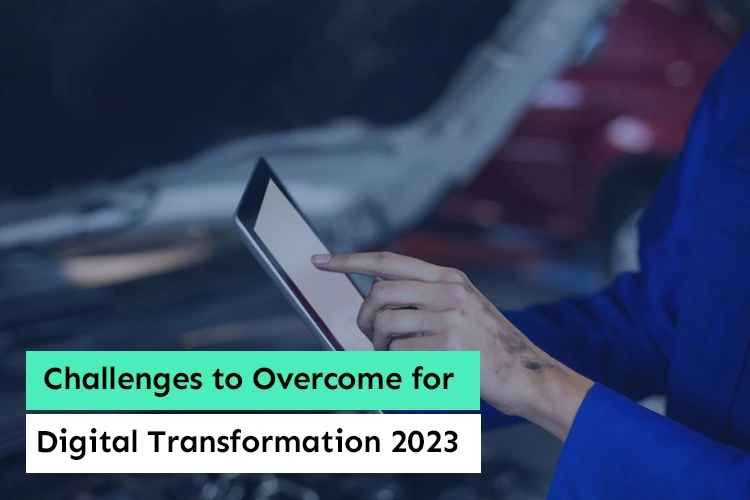Challenges to Overcome for Digital Transformation 2023

As the year 2023 approaches, businesses must define a route in a market marked by extraordinary difficulties and unrivaled opportunities brought about by technology.
Whether you own a small business or a startup, digital transformation is inevitable. It seeks to transform your organization and its assets digitally to increase efficiency. AI, IoT, and big data are examples of digital transformation technologies that have the potential to revolutionize your business operations and ensure growth.
Many firms are looking to digital transformation as a way to stay current with trends and stay one step ahead of the competition. Businesses, like any other change management initiative, may face challenges during the transformation process. These challenges could vary from people-centered concerns to structural constraints to technological limitations, and everything in between.
We’ll list the main obstacles to digital transformation in this blog post and provide some advice on how to get beyond them. Businesses can create a roadmap for success as they begin their digital transformation journey by taking into account all of these factors. Stay ahead!
What is Digital Transformation?
Simply described, digital transformation is the process of creating new business models using digital technologies. The objective is typically to reduce business pain points, boost efficiencies, and offer a more specialized customer experience.
The concept behind digital transformation is those technological advancements from custom software development, and web development, to ERP solutions, can improve every area of an organization. In other words, these technologies can help organizations enhance their systems and cultures so they can continue to be competitive and relevant.
For many companies, digital business transformation is essential to ensure their long-term survival in a cutthroat industry. Companies are becoming more connected and data-rich over time. By moving in this direction, you can derive the following benefits:
- A better consumer experience
- More comprehensive, actionable data
- Increased adaptability, agility, and creativity
Why Is Digital Transformation Difficult?

Digital transformation is more than just implementing new software, technologies, and procedures that are more efficient and automated than traditional business practices and processes; it is a completely new, inventive way of accomplishing something fundamental to your company.
That means that before embarking on a digital transformation program, firms must evaluate everything, including how people will react to the change, how it will affect customer relations, the cost, how it will connect with corporate goals, and so on. Digital transformations enable enterprises to take their businesses into the future, positioning them to compete and expand into new markets.
Also Read: Why AI Based Software Development Is A New Trend In 2021?
However, according to statistics on digital transformation, just 16% of employees thought that their company’s digital transformation initiatives improved or were sustainable, and 70% of all digital transformation projects fail to owe to employee resistance and a lack of management support.
Challenges to Overcome for Digital Transformation 2023:
1. Lack of a Defined Strategy:
The term “digital transformation” has entered the language as the business sector has grown increasingly digitized. Despite all of the rhetoric about digital transformation, there is still a lot of uncertainty about what it implies. Simply installing new technology is insufficient.
To truly alter your firm, you must rethink everything from the ground up. Too often, businesses start on digital transitions without a clear vision of what they expect to accomplish. As a result, many changes fall short of their potential, hampered by high expectations and ill-defined aims. A successful digital transition involves meticulous preparation and a clear grasp of your goals.
2. Security Challenges:
A company must abandon on-premise solutions in favor of shifting everything to the cloud and combining all of its data into one centralized system to successfully undergo digital transformation. While maintaining uniformity across all departments and developing a system that can be managed and monitored more efficiently might be a challenging process, it is vital.
Businesses must choose a fully-reliant strategy to counteract any cyber security danger. Companies must be ready for the growth in cyber attacks. There are various methods to accomplish this, but having a strategy in place is the best way.
3. Driving the Adoption of New Tools & Processes:
Even if there are more powerful and agile platforms available, businesses still employ legacy systems. When it comes to their fundamental systems, many businesses are reluctant to adopt newer technologies. Upgrades to legacy systems frequently involve a substantial time and money investment and can be difficult to implement.
For many businesses, legacy systems are the biggest barrier to digital transformation. Many businesses continue to employ outmoded software and tools. As a result, there is a lack of productivity and the company cannot compete with other companies. For the company’s operations to improve, legacy systems need to be modernized.
There is no doubt that outdated software can stymie a business. Outdated applications are frequently slower and more rigid, making it more difficult to respond to changes and integrate with new technology. This is especially true when a business is undergoing digital change. Companies must quickly update their systems and procedures to capitalize on new opportunities.
4. Evolving Customer Needs:
Recognizing that customer needs have changed since the virus’s origin is essential while the pandemic persists. For instance, while some people would want to continue working despite the risks, others might need to stay at home to safeguard their families. Keep in mind that each person’s needs are different, and businesses should change as necessary.
On the other side, implementing a digital transformation is a difficult project that can take years to complete. Successful transformations must take into account the specific requirements of each organization, the regulatory setting, and the available technology.
5. Absence of IT skills:
For those who need to integrate new technology, the shortage of talent in the industry presents a significant hurdle in the digital transformation process. According to a recent poll, 28% of respondents thought this was a barrier that was slowing their adoption rates since they couldn’t quickly reach subject matter experts or specialists. This shortfall can be ascribed to firms’ disjointed goals, compartmentalized decision-making, and cultural issues related to how they spend time and money on technologies.
Also Read: Best Software Development Services in India: 10 Tips You Need to Follow
Employee training on self-service digital/low-code technologies is crucial, but preparing them for complex digital business environments requires much more. Building IT resources’ digital dexterity and filling in the enterprise’s digital skills shortages can thus have a positive impact on resourcing. CIOs must work together to make sure that sufficient resources are allocated to the right initiatives on time.
6. Budget Constraint:
As your business expands, maintaining budget management can be challenging. If you do not have a clear understanding of your income and expenses, it may be challenging to make good financial decisions. This is particularly valid for tasks with plenty of moving parts. Furthermore, scope creep is easy to fall into if your business lacks a clear plan, leading to decisions that incur unnecessary costs. Your budget could be swiftly depleted by this, making it impossible to meet your deadline.
7. Lack of Technical Resources:
Businesses increasingly struggle with a lack of not just staff but also other resources necessary for the implementation of digital initiatives. These include, for instance, cash, time, and patience. Because businesses cannot implement digital initiatives without the necessary talent, a talent shortage is the most serious problem. Equally important are other flaws that could thwart the implementation of digital efforts.
How to Overcome Digital Transformation Challenges?

The challenges of digital transformation sometimes seem insurmountable, and certain things are out of your control. However, there are actions you can take to get around problems and lead your business through a seamless transition to a digital future. Here are tips to get you beyond the challenges.
1. Create a Solid Implementation Plan:
A solid implementation strategy must be in place to support your vision for the digital future. Your efforts should be complemented with a business IT plan that ensures consistency throughout. To encourage long-term adoption, develop a plan for integrating scalable systems for business architecture, cybersecurity, cloud services, analytics, and other areas.
2. Align Your Initiatives with Business Outcomes:
One of the first stages of a successful digital transformation is to align your objectives with business results. Place a higher priority on digital investments that directly affect the stated goals. To decide where to spend your money and which initiatives to prioritize, use outcome-driven criteria. Create a unified vision that aligns with the priorities of your business.
3. Make it a Core Element of Digital Transformation:
Although it can be difficult, organizational change is essential for transformational growth. Both cultural and attitude adjustments within the entire firm are required for this.
Start by identifying cultural restrictions on technological change. Adopt a change management plan after creating a comprehensive and consistent roadmap. Keep in mind that change needs to start at the top. Minimizing employee resistance is crucial.
4. Maintain Transparent Communication:
A recent Gartner survey found that 65% of decisions made now are more challenging than those made in previous years. Involvement in the decision-making process is increased due to them, both in terms of alternatives and parties.
You must keep lines of communication and feedback loops open with all stakeholders to make wise judgments. This will help to break down data silos and contextualize business decisions.
5. Create a Clear Strategy for Purchasing Technology:
Internal budget management is possible, but you typically have little control over other resource limitations. Create a clear strategy for purchasing technology to minimize bottlenecks during your transition.
Also Read: Ultimate Guide To Pick A Software Development Outsourcing Partner in 2023
To assess your current technology and find fresh approaches for your digital transition, conduct a technology evaluation. Look for alternate solutions whenever possible. Include technical resource constraints in your risk management plan to help reduce potential dangers.
6. Enhance Your Cybersecurity Strategy:
Your cybersecurity capabilities must be continually improved if you want to achieve secure digital transformation. A proactive monitoring system should be in place to resolve issues before they develop into high-risk breaches. Utilize patch management when using third-party programs to find vulnerabilities.
Your transformation plan must include your cybersecurity strategy as a crucial part. An adequate budget is also necessary for effective security measures. However, the price of risk reduction will undoubtedly be higher. As a result, make sure that cybersecurity and risk management frameworks are in place.
7. Have a Comprehensive Financial Strategy:
Although implementing new digital solutions is expensive, doing so is necessary for corporate success. However, sloppy planning and management may result in spending more than you had planned. Create a solid financial strategy for your digital shift to avoid this. Estimate the costs, potential long-term benefits, and investment returns before implementing the change. Think about the extra expenses your digital move will bring as your business expands.
8. Bridge the Skills Gap:
By funding education and training, you can improve the digital proficiency of your employees. This will guarantee that they have the knowledge and abilities needed to adjust to the digital shift and successfully incorporate digital tools into their work processes. Along with closing the digital skills gap, this enables and encourages your staff to perform better.
9. Broaden Sourcing Criteria:
Another method for bridging the digital skills gap is to broaden our sourcing standards. By looking for digital skills outside of IT roles or by utilizing the global talent pool, you can expand your talent pool. Spend money on products that support the usage of a distributed workforce. You might also think about giving tasks to outside teams who have the required technical know-how.
10. Find The Best Software Development Services for Your Business:
One of the easiest ways to overcome digital transformation challenges is by investing in software development services like Imenso software. Aside from avoiding employee pushback towards new digital solutions, these enable your business to leverage new technology without the need for specialized tech skills. All you need is to share your requirements, and the experts will take care of it.
Wrapping it Up
The term “digital transformation” refers to a comprehensive approach to altering company processes. In layman’s terms, digital transformation refers to digital technologies that improve the efficiency of various activities.
To complete this process successfully, you must have a fresh set of eyes on the platforms, tools, data, procedures, and technology you are employing. Keep an open mind because there will almost always be a need for some type of critical adjustment.
You can overcome these difficulties by removing the impediments to change. Change the structure and culture of your organization. Use a flexible design that can handle a variety of technologies. Most essential, choose the correct digital transformation platform, such as Imenso software, to assist you in developing a scalable business.
Similar Posts

Magento vs. Shopify: Choosing the Right E-Commerce Platform for Your Business
Are you in search of the perfect e-commerce platform that will take your business to new heights? The world of online selling offers a myriad of choices, each promising unique features and advantages. It’s a daunting journey, as over 75% of businesses face the challenge of selecting the right platform for their online store. Fear […]...

The Critical Role of .Net Support in Modern Application Development for Startups
Imagine a top e-commerce retailer seeing huge traffic spikes during holiday sales. The app faces a sudden surge in orders. This causes a system crash within a few minutes. This is due to weak performance and unsecured software vulnerabilities. As a result, the company loses customer satisfaction and sales revenue. This has a negative effect […]...

What Is CMS? And Why Your Website Must Have One
You can make a website in 10 minutes now, thanks to modern CMS platforms. And it’s not just a marketing campaign to entice business owners into trying a new tool. Building websites has never been easier. There are a vast number of no-code website builders available on the internet for free. You can create a […]...










